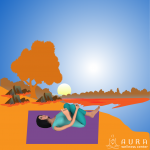I personally love to watch babies move. They roll, reach, and giggle at accomplishing what might seem to us like small goals. Sometimes they fall, struggle to get to where they want to be, and cry for a caregiver’s help. They are learning their bodies, ways to solve problems, how others react to their reactions, and what it is like for them to experience all of that in body and mind. All of those elements are the beginnings of the achievements, challenges, and inner/outer experiences that we all encounter throughout the lifespan. While the natures of those encounters differ for each individual, and notable exceptions do exist, there is a generalized sequential pattern of movement milestones that individuals achieve in the early years of life. Dance/movement therapy and other somatic disciplines rely upon this universal pattern to guide individuals to optimal holistic health. While yoga instructors and practitioners already (seemingly naturally) connect with this developmental somatic knowledge, we can even further utilize it in how we practice and guide others in practice.
First, babies enter the world with 1) breath – therein evidently the first most essential ingredient for life. It is no coincidence that most practitioners, and most instructors guide their students to, begin asana practice by cueing into the quality of breath. The goal in this phase is to reach the type of breath that will support the individual in the upcoming task. We equally need this preparation through breath in various types of asana practice, as babies rapidly learning and growing, and in diverse life experiences.
Secondly, little ones become aware of the world of sensations that is available to them by engaging with their environments through 2) touch. Babies learn much about themselves, others, and inanimate objects through pulling, stroking, chewing (engaging with touch through their lips), et cetera. In yoga, hands-on assists (from instructors, yet sometimes even from ourselves) and limb-on-limb points of contact (such as in binds) can guide us to make healthful adjustments to our postures. In sometimes less definable ways, those practice elements can engage our bodies’ intuitive senses – in ways that words never will – to feel more truly alive and whole within our practices.
Branching out more into their worlds, infants then begin to balance their movements in the realm of 3) core-distal. They have developed enough muscular strength and integration to reach their limbs out from their small bodies when it might help them to meet their needs – yet also to bring their body parts closer to their bodies’ centers when that is more satisfying and/or necessary. Asana practice plays with a similar balance between engagement of the core, necessary for balance and optimal alignment – and sending energy out into the distal (peripheral) parts of our bodies, which is imperative for achieving the most possible flexibility, other fitness markers, and simply sense of aliveness.
Then babies begin to sense a connection between 4) head and tail. At about five months old, they can – for the first time – fully lift their heads. Through that they experience both the practicalities as well as pleasures involved with stabilizing their movements through their spines. All central aspects of yoga practice – including asana, pranayama, and meditation – rely on this relationship of the head and tailbone. In asana, the appropriate relationship of those two parts is essential for balance and safe alignment, among other important components. In pranayama, a straight and stable spine is necessary to position the lungs for optimal breath capacity. In meditation, one’s spine must stay similarly straight and stable in order to minimize physical sensation – therein allowing one to get closer to the quiet, undisturbed consciousness that the practice can offer.
There are further possibilities yet! Stay tuned to learn about the four movement patterns within this largely universal sequence that we generally develop last, and then keep most central in our experiences throughout life. Those include abilities to expand one half of the body into space while keeping the other grounded, and conversely to move “cross-laterally” – moving arms and legs in opposite and sequential fashion. Those skills have implications for nothing short of our abilities to balance and “locomote” (walking, running, skipping, etc.) throughout life. Understandings of these natural connections, and resulting movement tendencies, can lead yoga practitioners and instructors to create practices that are true to our bodies – and through that are capable of contributing to expanded overall holistic health.
© Copyright – Aura Wellness Center – Publications Division
See our testimonials to find out what our graduates have to say about our selection of inexpensive hatha yoga instructor training intensives.
Please feel free to share our posts with your friends, colleagues, and favorite social media networks.
Related Posts
Yoga Training as a Method for Spinal Health
Yoga & Self-Hypnosis to Quit Smoking
Yoga Postures – Dynamic, Not Static!


Understandings of natural connections, and resulting movement tendencies, can lead yoga practitioners and instructors to create practices that are true to our bodies. Thanks for sharing this nice article.
Stay tuned to learn about the four movement patterns within this largely universal sequence that we generally develop last, and then keep most central in our experiences throughout life.
Thanks for sharing this valuable article.
I agree with Masud. Understanding natural connections and movements will make the practice of yoga better. Yoga is a way for connecting with the body, and going along with the natural flow of movements will make the practice more enjoyable instead of just an ordeal one should conquer.
Understanding these developmental patterns will make it easier for everyone to tailor their yoga practice, especially when doing it at home. Healthy living starts from within, and these developmental milestones should be considered so that bad habits can be avoided.
Thank you it was very informative and totally helped knowing the yoga movement for beginners.